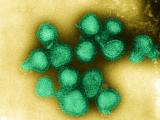(CIDRAP Business Source Osterholm Briefing) – After seeing the pandemic alert level sit at phase 3 for years, suddenly witnessing the World Health Organization (WHO) accelerate from phase 3 to phase 5 in mere days feels terribly unnerving. Unfortunately, it's the nature of the beast—literally.
Influenza viruses are notoriously unpredictable. And now this novel swine-origin virus is proving the case I've tried to make for years. If you haven't already done so, activate your pandemic plan now. All your preparations, your tabletops exercises, your months of meeting and revising and refining are about to prove of great value. If you don't have a plan, I urge you to move quickly to do as much as you can to get ready.
That said, here's what bears repeating: This virus remains unpredictable. It may surge ahead into a deadly pandemic in days, weeks, or months. Then again, it may fizzle out completely. Or it could disappear for a while, then return in a few months with a vengeance. We all need to practice these words: We just don't know.
Changing to the most useful mindset
Probably the hardest part of this pandemic phase is helping your employees make a psychological adjustment. Panic is a waste of energy. And ignoring the warnings is foolhardy. In other words, this phase is a big deal. Period. No getting around it. Time to get used to that idea.
International risk communication consultant, Peter M. Sandman, PhD, Deputy Editor of CIDRAP Business Source, has some useful observations about how the US government has been handling communications with the public. He credits officials from the Centers for Disease Control and Prevention (CDC) for being candid about the facts, though he'd like to see them urge people to make more individual preparations. Still, the gold standard of crisis communication, he says, "is to say alarming things in a calm tone." Richard Besser, MD, CDC's acting director, is doing exactly that.
That's an excellent takeaway message for the business community. Be candid and don't back off from explaining the full range of possibilities. Employees need to understand that coping with the outbreak could be more like a marathon than a sprint.
Encourage your employees to do something
Now is the time to remind employees to take care of their household's needs: extra food, water, prescription medications, a full tank of gas in the car, and, if possible, cash in their wallets. For both logistical and psychological reasons, everybody should be asked to take action, not simply "cover their cough and watch while the authorities cope," to quote Peter. It's much more "calming to prepare."
How will CIDRAP Source help you?
We're just at the beginning of phase 5 and much is still unclear—vaccine manufacturing, when to deploy antivirals, supply-chain issues, and more. We're watching these developments closely and using our expertise to translate complicated healthcare and scientific information into authoritative, reliable intelligence you can use.
To that end, you can expect to receive:
- Osterholm Briefings, when I can give you helpful context or interpretation or I'm hearing the same question coming from multiple business leaders
- Osterholm Briefing Updates, which will give you the latest-breaking news
- Alerts, when a new development requires immediate action
For now, we're going to pay special attention to the categories of Employee Protection, Government Watch, and Communication. We know that you are trying to sort through chaotic messages coming from media outlets that have suddenly taken an interest in what looks to be an emerging pandemic. So we will stay focused on what the latest developments mean to business. And we'll keep the communication succinct.
Expect to see updates like this:
- Dr. Margaret Chan, head of the WHO, today raised the agency's pandemic alert level to phase 5, one notch below a full-scale influenza pandemic, signaling that it's time for all countries to prepare. [Margaret Chan's statement]
- The CDC today reported a total of 91 confirmed cases of swine flu in 10 states, with 51 cases in New York City. Besides New York, affected states and case numbers are Arizona, 1; California, 14; Indiana, 1; Kansas, 2; Massachusetts, 2; Michigan, 2; Nevada, 1; Ohio, 1, and Texas, 16. [CDC swine flu page]
- WHO said it knew of 148 confirmed swine flu cases in nine countries as of 18:00 GMT today. These included 13 in Canada, 91 (with 1 death) in the United States, 26 (with 7 deaths) in Mexico, 2 in Israel, 4 in Spain, 5 in the United Kingdom, 3 in New Zealand, 1 in Austria, and 3 in Germany.
- A 22-month-old boy from Mexico City died in a Houston, Tex., hospital earlier this week, marking the first swine flu death in the United States and the first outside Mexico, the Texas Department of Health Services (TDHS) reported today. The boy's close contacts have remained healthy, officials said. [TDHS news release]
- Germany reported three swine flu cases and Austria reported one, according to a Reuters report today. The patients included a Bavarian couple in their 30s, a 22-year-old woman from Hamburg, and a 28-year-old Austrian.
- New York and Indiana have received their full allotments of influenza antivirals from the Strategic National Stockpile, and all other states will receive theirs by May 3, Dr. Richard Besser, acting CDC director, said in a press briefing held by the US Department of Health and Human Services (HHS).
- A "reference strain" of the swine flu H1N1 virus has been isolated by the CDC and sent to vaccine manufacturers, Dr. Anthony Fauci, director of the National Institute of Allergy and Infectious Diseases, said at the HHS briefing, adding that limited pilot lots of vaccine could be available for human trials in "early fall."
- The US Food and Drug Administration (FDA) has organized its swine-flu response into an "incident management" structure of seven teams—vaccine, antivirals, personal protective equipment, blood needs, diagnostic research, shortages, and consumer protection—acting FDA Commissioner Dr. Joshua Sharfstein said at the HHS briefing.
- Only 3 of 14 US swine flu patients with known travel histories had been in Mexico, the CDC said in an MMWR Dispatch last night. Forty of the 64 confirmed cases were not linked to travel or to another confirmed case. [Apr 28 MMWR Dispatch]
- Between Apr 19 and 27, federal officials checked 15 sick travelers entering the United States from Mexico and confirmed that 2 of them had swine flu, the CDC said in the MMWR Dispatch. Nine travelers remained in isolation pending further evaluation, and four travelers were released.
Bottom line for business
Put your plans into action. Help your employees make a critical psychological shift and prepare their households. And stay tuned.



















